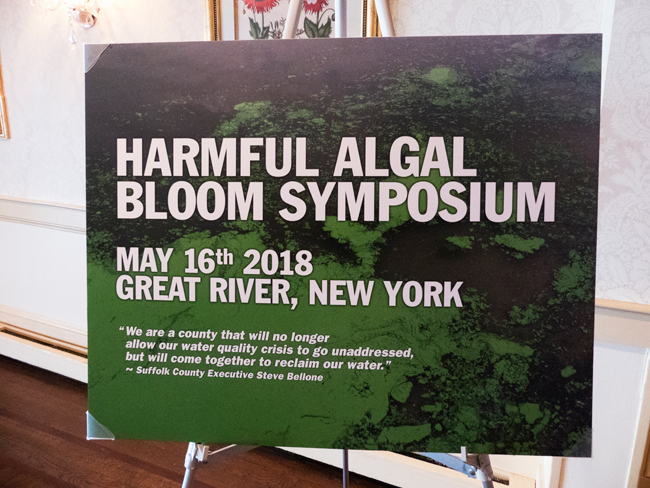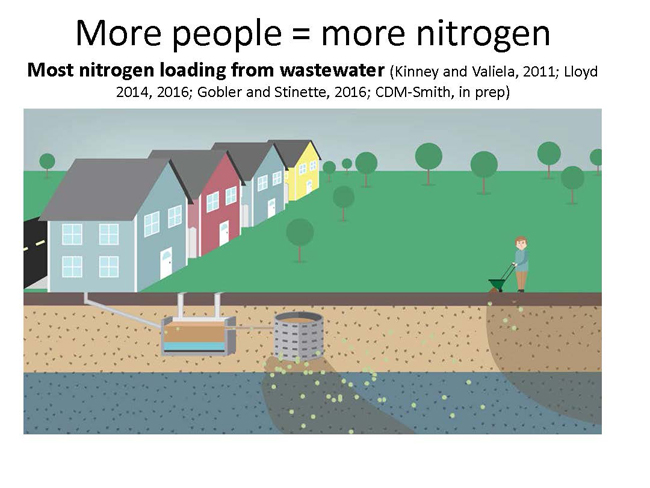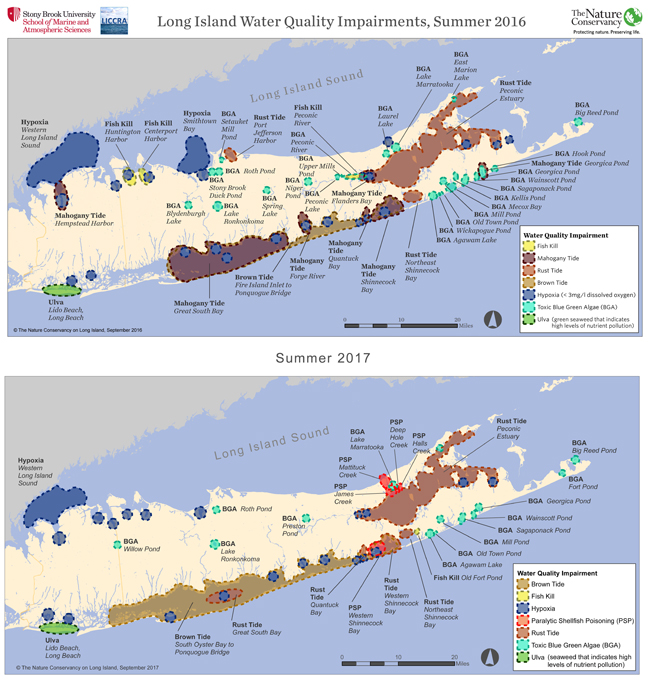
Credit: Ryan Strother / NYSG.
Contacts:
Antoinette Clemetson, Marine Fisheries Specialist, NYSG, E: aoc5@cornell.edu, P: (631) 632-8730
Great River, NY, May 16, 2018 – New York Sea Grant (NYSG) in partnership with the Suffolk County Department of Health Services hosted the 2018 Suffolk County Harmful Algal Bloom (HAB) Symposium. Funding for this meeting was facilitated through a National Oceanic and Atmospheric Administration (NOAA) grant that was awarded to Dr. Christopher Gobler, a professor at Stony Brook University’s (SBU) School of Marine and Atmospheric Science (SoMAS), and a leading harmful algal bloom researcher. The meeting is the first in a series of public outreach meetings on HABs.

Presenters at the workshop included NYSG's Bill Wise (at left) and Chris Gobler (at right), the Associate Dean for Research and a professor at SBU's SoMAS. Credit: Ryan Strother / NYSG.
NYSG Director Bill Wise gave the opening remarks at the conference. New York Sea Grant began efforts to develop the Suffolk County HAB action plan two years ago. The initial efforts involved a meeting with the public, and then a steering committee with multiple agencies was established.
“Long Island is ground zero for HABs,” Wise said, commenting on the importance of proper coordination of HAB management in Suffolk County.
Wise explained the origins and contents of The Suffolk County HAB Action Plan, which is a blueprint for funding to prevent and minimize Long Island’s blooms. The action plan concludes that the severity and incidences of harmful algal bloom outbreaks have continued to increase in occurrence and severity in Suffolk County over the years, with more than thirty occurrences recorded in the past decade. Harmful algal blooms can put a halt to shellfish harvesting and bathing beach closures, resulting in a major disruption to the fishing and outdoor recreation industries.
The HAB Action Plan offers key management decisions and actions and recommends strategies that reduce nitrogen and phosphorus loading to ground watersheds, surface watersheds, and direct inputs to surface waters, particularly by upgrading septic systems. NYSG first provided a roadmap for HAB research and education on Long Island in 1999 with the Brown Tide Research Initiative, a multi-year effort with an archived report series at www.nyseagrant.org/habs. Other recommendations of the HAB Action Plan deal with HAB management coordination, management interventions apart from nutrient limitation (e.g. seaweed bioextraction of nutrients) and research and monitoring needs.

Excessive nitrogen is a key ingredient in more potent (and potentially toxic) algal blooms. The Suffolk County HABs Action Plan calls for, among other things, regulating the use of fertilizers, which SBU researcher Chris Gobler said accounts for 10-12% of nitrogen load into LI waters. Credit: Chris Gobler.
Dorian Dale, the Director of Sustainability and Chief Recovery Officer for Suffolk County, spoke on the importance of wastewater treatment in managing HABS. As much as 75% of wastewater in the county is untreated, and Suffolk County has rates of fertilizer use two times higher than anywhere else in New York State. Untreated wastewater and fertilizer problematically produces excess nitrogen and phosphorus. More nitrogen makes blooms more intense and toxic. The more nitrogen loading occurs, the more algae blooms and dies off. Toxic species of algae may produce toxins during this process, though not all blooms involve toxic species.
At the time of the Symposium, there had already been three confirmed HABs in Suffolk County in 2018. These HABs come in various forms – including brown tide, red tide, blue-green algae, the latter of which occurs in Suffolk County more frequently than any of the other 47 New York counties that have blooms. With more phosphorus there comes more blue green algae and, therefore, more intense blooms.
Some algae produce harmful toxins that bivalve mollusks such as mussels, scallops, clams and oysters can acquire through their water filtration processes. If these affected species are consumed by humans, they can result in gastrointestinal illness (diarrheic shellfish poisoning, DSP) or paralytic shellfish poisoning (PSP). Some of the toxins related to PSP are 1,000 times more potent than cyanide; toxic levels contained in a single shellfish can be fatal to humans. Buying shellfish from reliable and licensed seafood shops, eating smaller amounts of shellfish in any one meal and avoiding consumption of the cooking liquid can help prevent such illnesses.
Christopher Gobler presented on the causes and consequences of nutrient loading (the abundance of nitrogen and phosphorus) in Long Island’s waters, which he mentioned were HABs-free from 1954 to 1985. Since then, blooms have become a more common occurrence, and other water quality symptoms have cropped up as well.
Nutrient loading causing coastal eutrophication has had several consequences. Gobler mentioned that due to this dense growth of plant life fueled by higher nitrogen and phosphorus levels Long Island has lost 90% of its sea grass. If nothing is done, all the remaining seagrass ecosystems could be gone in the next decade. Additionally, Long Island has lost significant amounts of wetlands in the past several decades due to eutrophication. Also, lower dissolved oxygen (hypoxic) conditions and higher concentrations of these algae have put the lives of many aquatic animals at risk.
As the population of Long Island has increased since 1985, the concentration of nitrogen in the ground water has also increased. Excessive nitrogen loading is an ongoing threat to coastal ecosystems, economies, pets and human health across Long Island. Most HABs in Suffolk County can be linked to excessive nutrient loading; other drivers include the loss of shellfish and rising temperatures associated with climate change.

Managing harmful algal blooms such as brown and red tides and blue-green algae in Suffolk County is unique because all of Long Island is a single watershed, and all materials on land eventually enter the ground water and surface waters on and around its borders. Credit: Chris Gobler.
Walter Dawydiak, representing the Suffolk County Department of Health Services (SCDHS), presented the key HAB Action Plan management recommendations. The top strategic priority is to reduce nitrogen and phosphorus loading to ground watersheds, surface watersheds and direct inputs to surface waters, particularly by upgrading septic systems. One such program in Suffolk County is the Septic Improvement Program (SIP). As of May 7, there are 188 active SIP grants. Individual homeowners in Suffolk county may be eligible for grants up to $11,000, most of which will be provided for the purchase and installation of an approved improved septic system.
Other examples of recommendations include: establishing an ongoing HAB Management Workgroup, and convening further annual symposiums, conducting assessments of seaweed farms and shellfish aquaculture facilities’ effect on HABS, actively endorsing green infrastructure projects limiting the discharge of nitrogen to surface waters via storm runoff.
James Ammerman, the Science Coordinator at the Long Island Sound Study who is an employee of the New England Interstate Water Pollution Control Commission (NEIWPCC), presented successful examples of HAB mitigation and management efforts.
“HABs are a global problem,” Ammerman said. “We just have a piece of them.”
Ammerman’s presentation focused on efforts around the globe that target HABs and analyzed what can be learned from other situations. He cites Lake Erie, the source of drinking water for approximately 11 million people, as a model for how severe the issue can get. While the hope is for decreasing nutrient levels to lower chlorophyll levels and the frequency of HABs, this is not simply a process of re-tracing ecological steps. Ammerman warns that we need to be prepared for water bodies not to spring back to what they were like pre-HABs outbreaks—once a eutrophication problem is established, the baseline for a healthy ecosystem often shifts to something different.
Ammerman stresses that the greatest successes in HAB management have come from dedicated leadership, a bottom-up collaborative governance process, specific ecological goals, and a reduction in all nutrient sources. Strategies like this have been successfully implemented with by the Tampa Bay Estuary Program and in Chesapeake Bay. More locally, he says that only 70 square miles of Long Island Sound exhibited hypoxic conditions in 2017, a continuing decrease probably due to the reduction in nitrogen loading.
Several initiatives have been borne out of the HAB symposium and the Action plan. There are currently five shellfish restoration sites in Suffolk and Nassau Counties, and many investments in fish hatcheries—an aggressive, and potentially risky effort, as these strategies are costly and use taxpayer dollars.
More information on Harmful Algal Booms and related efforts from New York Sea Grant can be found at nyseagrant.org/habs.
This project is partially funded by the NOAA Ecology and Oceanography of Harmful Algal Blooms (ECOHAB) Program Award # NA17NOS4780201 to facilitate harmful algal bloom information dissemination. The statements, findings, conclusions, and recommendations on this webpage do not necessarily reflect the views of New York Sea Grant or ECOHAB.
More Info: New York Sea Grant
New York Sea Grant (NYSG), a cooperative program of Cornell University
and the State University of New York (SUNY), is one of 33 university-based
programs under the National Oceanic and Atmospheric Administration’s
National Sea Grant College Program.
Since 1971, NYSG has represented a statewide network of integrated
research, education and extension services promoting coastal community
economic vitality, environmental sustainability and citizen awareness
and understanding about the State’s marine and Great Lakes resources.
Through NYSG’s efforts, the combined talents of university scientists
and extension specialists help develop and transfer science-based
information to many coastal user groups—businesses and industries,
federal, state and local government decision-makers and agency managers,
educators, the media and the interested public.
The program maintains Great Lakes offices at Cornell University, SUNY
Buffalo, SUNY Oswego and the Wayne County Cooperative Extension office
in Newark. In the State's marine waters, NYSG has offices at Stony Brook
University in Long Island, Brooklyn College and Cornell Cooperative
Extension in NYC and Kingston in the Hudson Valley.
For updates on Sea Grant activities: www.nyseagrant.org has RSS, Facebook, Twitter, and YouTube links. NYSG offers a free e-list sign up via www.nyseagrant.org/nycoastlines for its flagship publication, NY Coastlines/Currents, which is published quarterly. Our program also produces an occasional e-newsletter,"NOAA Sea Grant's Social Media Review," via its blog, www.nyseagrant.org/blog.